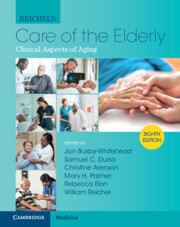Book contents
- Reichel’s Care of the Elderly
- Reichel’s Care of the Elderly
- Copyright page
- In Memoriam
- Contents
- Contributors
- Section I General Approach to the Care of the Elderly
- Chapter 1 Essential Principles in the Care of the Elderly
- Chapter 2 Biology of Aging
- Chapter 3 Comprehensive Geriatric Assessment
- Chapter 4 Screening and Prevention
- Chapter 5 Appropriate Use of Medications
- Chapter 6 Nutrition and Aging
- Chapter 7 Physical Activity and Exercise for Older Adults
- Section II Geriatric Syndromes
- Section III Care of the Elderly by Organ System
- Section IV Principles of Care for the Elderly
- Index
- Plate Section (PDF Only)
- References
Chapter 7 - Physical Activity and Exercise for Older Adults
from Section I - General Approach to the Care of the Elderly
Published online by Cambridge University Press: 30 June 2022
- Reichel’s Care of the Elderly
- Reichel’s Care of the Elderly
- Copyright page
- In Memoriam
- Contents
- Contributors
- Section I General Approach to the Care of the Elderly
- Chapter 1 Essential Principles in the Care of the Elderly
- Chapter 2 Biology of Aging
- Chapter 3 Comprehensive Geriatric Assessment
- Chapter 4 Screening and Prevention
- Chapter 5 Appropriate Use of Medications
- Chapter 6 Nutrition and Aging
- Chapter 7 Physical Activity and Exercise for Older Adults
- Section II Geriatric Syndromes
- Section III Care of the Elderly by Organ System
- Section IV Principles of Care for the Elderly
- Index
- Plate Section (PDF Only)
- References
Summary
Physical activity is fundamental for achieving healthy aging. Exercise offers older adults substantial benefits, such as reducing risks of all-cause mortality and chronic disease, preserving functional capacity, improving management of chronic conditions, and reducing health-care costs. Given the prevalence of physical inactivity and sedentary behavior among adults 65 and over, exercise needs to be more thoroughly integrated into care plans and counseling in primary care settings. A practical, three-step approach to exercise counseling is recommended. Older adults should strive to do at least 150 minutes of moderate-intensity aerobic exercise weekly, muscle-strengthening and flexibility activities twice weekly, and for those at risk of falls or with mobility problems, balance activities at least three times per week. Older adults with functional restrictions or chronic conditions should be as physically active as their abilities and conditions allow. Any amount of moderate-to-vigorous physical activity gains some health benefits. Appropriate physical activity counseling, prescription, and referral must be tailored for each patient and must take into account such factors as fitness levels, goals and motivations, access to exercise-related facilities and programs, chronic diseases, prescribed medications, common injuries, and hip and knee arthroplasties.
- Type
- Chapter
- Information
- Reichel's Care of the ElderlyClinical Aspects of Aging, pp. 64 - 80Publisher: Cambridge University PressPrint publication year: 2022



